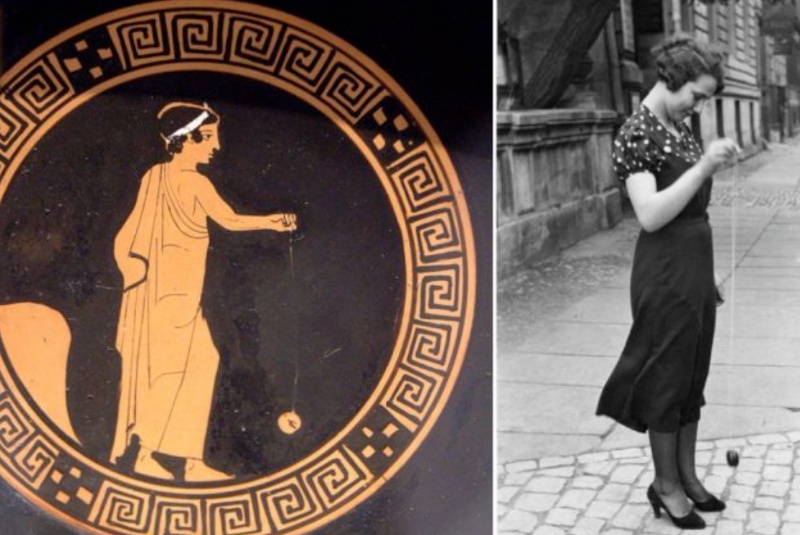The yo-yo is an object synonymous with childhoods across many generations, a simple yet captivating toy that has spun its way through history. While its exact origins remain shrouded in mystery, the collective understanding from historians suggests a Chinese inception. Nevertheless, the first documented reference hails from an unlikely source: ancient Greece. Historical accounts dating back to 500 B.C.E. indicate that Greek children were already enthralled by this spinning device.
But what did these early iterations of the yo-yo look like? It appears they were crafted from materials such as metal or wood, often adorned with vibrant paints to captivate the user’s eye. The term 'yo-yo' was not yet coined; these items were simply known as 'disks'. In a ritual marking the transition from childhood to adulthood, these toys were frequently offered to the gods. Given that many were made from clay, their fragility lent them to be sacrificial items. An artifact supporting this tradition resides in The National Greek History museum in Athens—a vase dated from 500 B.C.E. that depicts children playing with what seems to be a yo-yo, signifying the toy's importance in ancient Greek culture.

The narrative of the yo-yo takes an interesting twist in the 16th century in the Philippines. Here, an adaptation of the yo-yo took a more utilitarian role in the form of a hunting tool. Hunters would perch themselves on high trees, armed with a device akin to a yo-yo attached to a 20-foot cord. This ingenious setup allowed multiple attempts to strike prey from an elevated vantage point, retrieving the device via its cord in a motion reminiscent of the yo-yo’s up-and-down play.
Leap forward to 1798, and the yo-yo makes a royal appearance in a painting of King Louis XVII of France, merely four years old, engrossed in playing with a yo-yo. The French at the time referred to it as 'l’emigrette', an ironic prelude to the French Revolution’s exile of the royal family, as the term now translates to "Leave The Country".
The transition to the modern yo-yo can be traced back to its cultural significance in the Philippines. Here, the utility of the yo-yo as a hunting tool morphed over time into an artisanal craft. Filipino craftsmen, honed by their necessity-driven ingenuity, became adept at carving exquisite wooden yo-yos. As the toy's popularity soared, Filipino children mastered its use, elevating the yo-yo to the status of a national pastime.
In a pivotal moment for the yo-yo's history, during the 1920s, Pedro Flores emigrated to the United States from the Philippines, bringing with him the traditional wood-carved Filipino yo-yo. Recognizing a potential market in America, Flores established a company in California aptly named 'Yo-yo'. This move cemented the yo-yo’s place in toy history, marking the beginning of its rise to becoming one of the best-selling toys in history, despite its mysterious origins.
Exploring the Yo-yo’s Journey through Time and Culture
To appreciate the full spectrum of the yo-yo’s cultural impact, we must delve into its evolution through time and across continents. This modest toy’s journey is a reflection of human innovation, leisure, and even socioeconomic shifts. Each era brought with it a different manifestation of the yo-yo, reflecting the societal context of the time.
The yo-yo’s significance in the Philippines, for example, went beyond its practical use in hunting. It became a tool for entertainment and competition, fostering community and skill-sharing among youths. The craftsmanship required to create a well-balanced yo-yo also spoke to the artisan skills prevalent in the Filipino culture of the time.
In the West, the yo-yo's assimilation took a different route, becoming a mainstream pastime for children of all ages. The 20th century saw the yo-yo transform into a mass-produced object, available in various materials, colors, and sizes, thanks to industrialization. Marketing strategies evolved to promote this simple toy, from the classic wooden models to the more modern plastic designs with flashy colors and lights.
Yo-yo as a Reflection of Technological Advancement
The evolution of the yo-yo also mirrors technological advancements. From the hand-carved wooden versions to the use of synthetic materials like plastic, the yo-yo has been constantly reinvented. These materials allowed for more consistent performance and durability, catering to both novice users and professional yo-yo players.
Moreover, the yo-yo has found its place in scientific contexts as well. The principles of rotational dynamics that govern yo-yo movement have been used to explain concepts in physics, making the yo-yo a practical teaching tool in classrooms around the world. The yo-yo's motion, reliant on angular momentum and energy conservation, demonstrates the fundamental laws of motion in a tangible, accessible manner.
The Yo-yo in Popular Culture and Competitions
The yo-yo's imprint on popular culture is undeniable. It has been featured in movies, television shows, and even as a subject of pop art. The simplicity of its design and the skill required to manipulate it has made the yo-yo a symbol of youth and dexterity. Moreover, the yo-yo has given rise to a competitive scene, with national and international contests dedicated to the craft of yo-yo play. These competitions showcase the incredible artistry and technical skill involved in modern yo-yoing, propelling it far beyond its origins as a child’s plaything.
Contestants in these competitions often perform complex tricks and sequences that require intense practice and precision. The community around competitive yo-yoing is vibrant, with enthusiasts sharing tips, designs, and modifications to enhance performance. These gatherings are not just about competition; they are celebrations of a shared passion for a toy that has transcended time and geography.
The Yo-yo's Continued Relevance and Legacy
In conclusion, the yo-yo is more than a toy; it's a cultural icon that has withstood the test of time. Its origins, while mysterious, are a testament to human creativity and playfulness. From the ancient Greeks to Filipino hunters, from French royalty to American entrepreneurs, the yo-yo has rolled along the timeline of history, accumulating stories and significance.
Despite the digital age, where children's entertainment often resides in the virtual world, the yo-yo persists. Its physicality offers a respite from the screens, a return to tactile skill, and a challenge that is both personal and universal. As long as there are curious minds and playful spirits, the yo-yo will continue to be rediscovered, reimagined, and revered, spinning well into the future.
The yo-yo's legacy is secured not just by its longevity but by its ability to adapt and resonate with successive generations. It is a simple pleasure that harkens back to the fundamentals of play: skill, challenge, and enjoyment. From its enigmatic origins to its status as the ultimate selling toy, the yo-yo remains a fascinating subject of cultural and historical significance—a small but mighty force in the vast landscape of human invention.
In this piece, we have explored the yo-yo's history, its cultural significance, and its undiminished popularity. The yo-yo indeed demonstrates that sometimes the simplest of inventions can have the most enduring impact, spinning a tale as complex and diverse as history itself.




